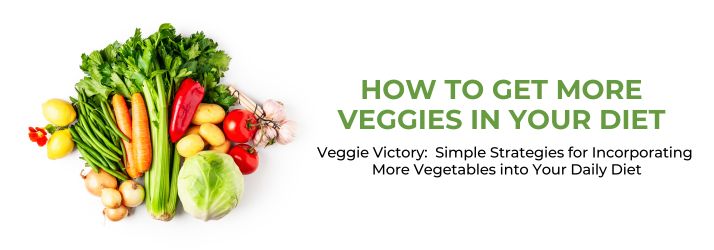How To Get More Veggies In Your Diet

Eating a diet rich in vegetables is crucial for optimal health, as they provide essential vitamins, minerals, and fiber that contribute to overall well-being. However, many people struggle to consume the recommended daily servings of vegetables. This article will outline easy and creative ways to incorporate more vegetables into your daily meals and snacks, helping you achieve a healthier, more balanced diet.
Start Your Day with a Veggie-Packed Breakfast
Breakfast is the perfect opportunity to begin incorporating vegetables into your daily diet. Here are some ideas to get you started:
- Add spinach, tomatoes, or bell peppers to your omelet or scrambled eggs.
- Blend spinach or kale into your morning smoothie.
- Top your avocado toast with fresh tomato slices or roasted red peppers.
Sneak Vegetables into Your Favorite Dishes
Incorporate vegetables into your favorite meals by blending, chopping, or grating them into the dish:
- Add grated carrots or zucchini to meatloaf or meatball recipes.
- Blend cooked cauliflower into mashed potatoes for added nutrients and creaminess.
- Incorporate finely chopped mushrooms into ground meat dishes, such as tacos or spaghetti bolognese.
Substitute Vegetable-Based Ingredients
Swap out traditional ingredients for vegetable-based alternatives to boost the nutritional value of your meals:
- Use spiralized zucchini, sweet potato, or beet noodles in place of pasta.
- Replace white rice with cauliflower rice in stir-fries or burritos.
- Swap out traditional pizza crust for a cauliflower or broccoli-based crust.
Embrace the Power of Snacking
Turn to vegetable-based snacks as a convenient way to increase your daily intake:
- Dip raw veggies, such as carrot sticks, cucumber slices, or bell pepper strips, into hummus or guacamole.
- Munch on oven-roasted kale chips or seasoned vegetable chips.
- Try vegetable-based snack bars or veggie-packed muffins for an on-the-go option.
Make Vegetables the Star of Your Plate
Instead of treating vegetables as a side dish, make them the main focus of your meal:
- Build a hearty salad with a mix of leafy greens, roasted vegetables, and a protein source, such as grilled chicken or tofu.
- Create a vegetable stir-fry with a variety of colorful veggies and a flavorful sauce.
- Roast a medley of vegetables, such as carrots, Brussels sprouts, and sweet potatoes, and serve them as the main course with a side of whole grains or protein.
Experiment with New Flavors and Cooking Techniques
Trying new recipes, flavors, and cooking techniques can make vegetables more exciting and appealing:
- Grill or roast vegetables to bring out their natural sweetness and add a smoky flavor.
- Season your vegetables with a variety of herbs and spices, such as garlic, rosemary, or chili powder.
- Explore international cuisine for unique and flavorful vegetable dishes, such as Indian curries or Mediterranean salads.
Plan Your Meals Around Vegetables
Incorporate more vegetables into your meal planning by ensuring each meal includes at least one serving of vegetables:
- Aim for half of your plate to be filled with vegetables at lunch and dinner.
- Plan a weekly meal menu that highlights a variety of vegetables, ensuring you get a wide range of nutrients.
- Keep frozen vegetables on hand as a convenient and nutritious backup option when fresh vegetables aren't available.
Incorporating more vegetables into your daily diet is essential for achieving optimal health and well-being. By following these simple strategies, you can easily increase your vegetable intake and enjoy the numerous benefits that come with a veggie-rich diet. Remember that variety is key; experimenting with different types of vegetables, flavors, and ways to cook them.
OFFICE HOURS
Monday
8:30am - 11:45am
12:30pm - 4:00pm
Tuesday
11:00am - 2:45pm
3:30pm - 7:00pm
Wednesday
11:00am - 2:45pm
3:30pm - 7:00pm
Thursday
11:00am - 2:45pm
3:30pm - 7:00pm
Friday
8:30am - 11:45am
12:30pm - 4:00pm
Saturday
8:30am - 11:45am
12:30pm - 4:00pm
Sunday
Closed
Reform Chiropractic
10345 Lakewood Blvd
Downey, CA 90241



